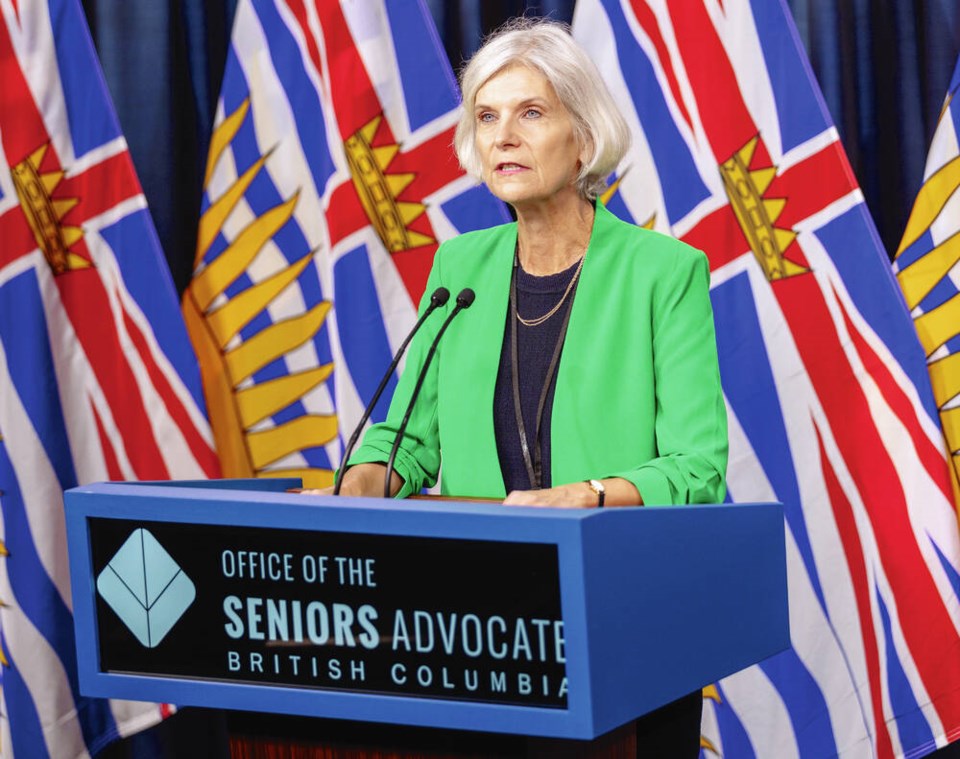For-profit long-term care facilities are making record profits from publicly funded beds, yet provide fewer resident care hours than non-profits, says the province’s watchdog for seniors.
On Monday, B.C. Seniors Advocate Isobel Mackenzie released her latest review, Billions More Reasons to Care, which looks at revenues and expenditures in long-term care in 2021-2022 compared to five years ago.
The report, an update to a 2020 report, comes as the wait for long-term care beds has risen 149 per cent and the number of beds per 100,000 population has dropped 13 per cent.
The review shows non-profits provided significantly more direct-care hours over the five-year period — 93,000 hours more than they were funded to deliver — while for-profit facilities provided 500,000 fewer hours, despite all publicly funded long-term care beds receiving the same amount per bed.
It says for-profit care homes more than doubled their profits over the five years, to $7,465 per bed from $3,439 per bed — more than seven times the amount of surplus generated by non-profit care operators.
B.C. has about 28,000 publicly subsidized long-term care beds. About two-thirds of those are contracted to private operators, including both for-profit companies and non-profit societies, with the remaining third owned and operated by health authorities.
Direct-care hours are those delivered to residents by registered nurses, licensed practical nurses, health-care assistants, and others, such as physiotherapists.
Since 2017, direct-care hours have increased under the B.C. NDP to meet provincial benchmarks set in policy, though Mackenzie said those hours should be increased and embedded into regulations.
Mackenzie is recommending “fundamental reform” of the funding model for publicly funded long-term care beds in the face of growing demand for beds, increasing wait lists, and rising costs and wages.
She said the current funding formula rewards for-profit facilities for providing less care at a higher cost.
A review of 181 facilities contracted to provide long-term care showed profits in 2022 increased 113 per cent over five years, while expenditures such as supply costs and staffing compensation rose 61 and 33 per cent respectively.
In 2020-2021, 80 per cent of total profit was concentrated in 20 per cent of care homes, almost all for-profit companies, she said. That’s the result, she said, of a funding formula that is not fair and equitable to all operators.
Mackenzie compared two 40-year-old, 150-bed facilities, showing the non-profit facility spent $12.9 million on staffing compared to the for-profit, which spent about $8 million on staffing. The non-profits, she said, put more money into wages and benefits, while the for-profits put more, in part, into building expenses and mortgages for facilities not owned by health authorities.
“We are rewarding not spending on the care,” said Mackenzie.
Not-for-profit facilities spent 25 per cent more per resident on direct care than for-profit facilities and less on buildings, while for-profit facilities spent 42 per cent more on capital building costs, she said.
Publicly subsidized long-term care clients pay up to $3,847 per month, while fully private long-term care runs up to $20,000 a month. Residents in fully private beds with no public funding can generally order the service levels they want, unlike those in subsidized beds.
Mackenzie suggests providers should only be compensated when they have spent the money provided for resident care on resident care. Allowing any direct-care funding to go to other areas has “gotten us into the muck we are in now.”
The $2-billion transfer from government to the private sector to deliver long-term care is one of the largest transfers the province undertakes on an annual basis, said Mackenzie.
“Over the past five years, the cost of publicly subsidized long-term care delivered by the private sector has risen 35 per cent — well beyond the rate of inflation,” she said. “It is crucial to understand where the money is going, how it is impacting residents’ care and whether the public is receiving good value.”
Mackenzie said consulting care providers regarding reforming the funding formula is important, but it’s naive to think that providers will agree to a deal that is equitable to all where they make a lot less money.
“We’re not partners in the delivery of care,” said Mackenzie.
“This is not an equal relationship. Government is the regulator and the funder.”
Meena Brisard, secretary business manager of the Hospital Employees’ Union, said the seniors advocate’s review shows contracted care-home operators — especially for-profit operators — are diverting public funds away from the front-line “to their bottom line.”
“Care home residents and health care workers are paying the price,” Brisard said in a statement. “Our seniors’ care system is pushed to the limit, and we have a responsibility to ensure public money goes to frontline care.”
Terry Lake, CEO of the B.C. Care Providers Association, which represents the majority of contracted not-for-profit and for-profit long-term care operators, said the association is in “deep discussions” with the Health Ministry and health authorities over a new equitable and transparent funding formula.
However, Lake said the 2021-2022 long-term care costs in Mackenzie’s report have yet to be finalized and some of the data is from the COVID-19 pandemic period. “To say this time was chaotic is an understatement,” said Lake. “It is difficult to have confidence in the current data, as reconciliation for COVID-related spending is still underway and it is irresponsible to draw conclusions for a COVID-impacted year.”
Health Minister Adrian Dix was not available for comment.
>>> To comment on this article, write a letter to the editor: [email protected]



